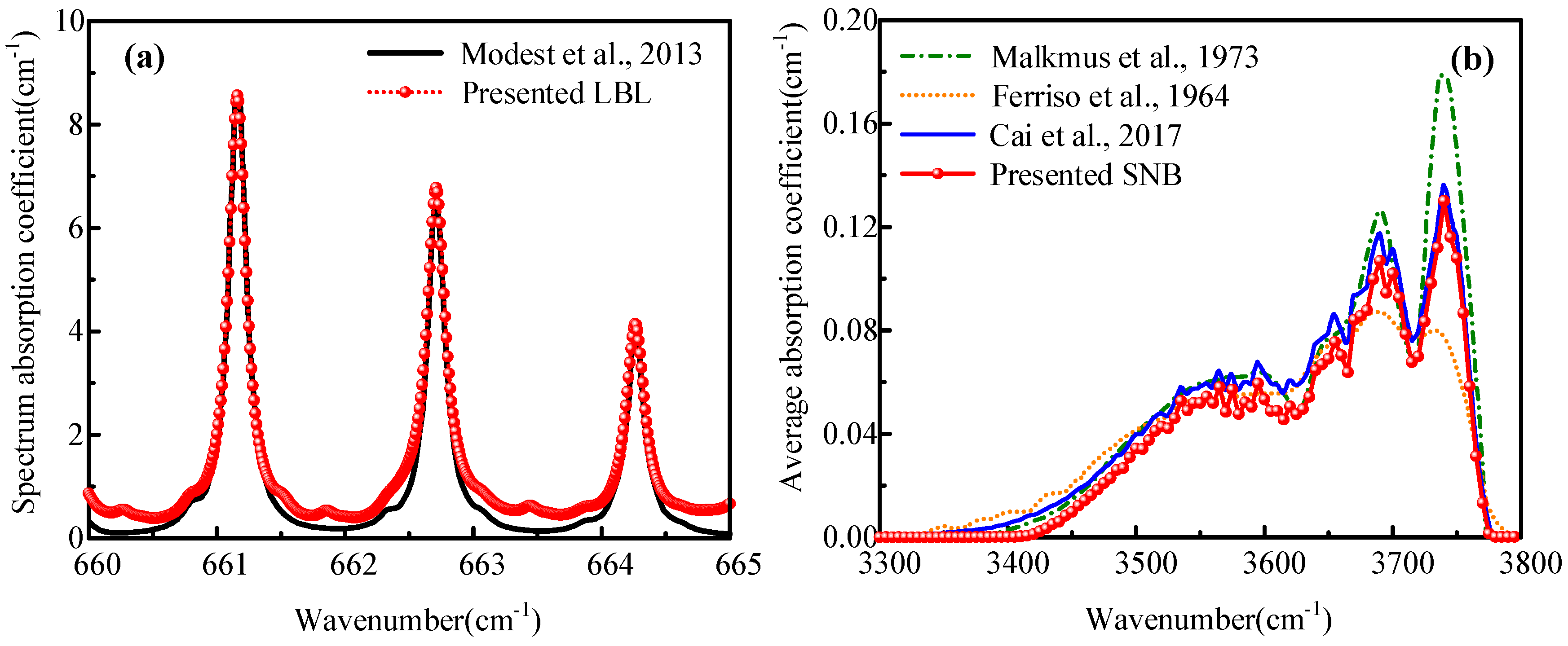Integrated Infrared Radiation Characteristics of Aircraft Skin and the Exhaust Plume
Abstract
1. Introduction
2. IR Characteristics Modeling for Aircraft Skin
3. Gas Radiation Characteristics and Exhaust Plume Radiation Calculation
3.1. Line-by-Line Calculation
3.2. Statistical Narrow Band Model
3.3. Line-of-Sight Method
4. Results and Discussion
4.1. Aircraft-Skin IR Characteristics Analysis
4.2. Exhaust Plume IR Characteristics Analysis
4.3. Integrated IR Calculation of Skin and Exhaust Plume
5. Conclusions
- (1)
- The integral radiation intensity distribution of aircraft skin depends on the Mach number. The radiation intensity emitted by the skin is concentrated in the 8−14 μm waveband. In addition, the upper surface mainly reflects the solar radiation in the 3−5 μm waveband, and the lower surface mainly reflects the ground radiation in the 8−14 μm waveband. To reduce the IR signal of skin, it is necessary to reduce the visible area and reduce the emissivity and reflectance of skin material.
- (2)
- The radiation intensity of the exhaust plume is mainly concentrated in the 3−5 μm waveband. The radiation from the nozzle base has a great influence on the radiation intensity distribution of the exhaust plume, and the backward radiation intensity increases significantly when the effect of the nozzle base is considered.
- (3)
- The aircraft IR characteristic distributions of 3−5 μm waveband are concentrated in the exhaust plume and the high-temperature skin near the exhaust plume, while the IR signals of 8−14 μm waveband are concentrated in the skin. To reduce the IR signal of the nozzle, it is better to reduce the temperature of the core area of the exhaust plume and adopt low-emissivity materials in these parts.
Author Contributions
Funding
Institutional Review Board Statement
Informed Consent Statement
Data Availability Statement
Acknowledgments
Conflicts of Interest
Nomenclature
| Ai | area of surface element i |
| B | derivative of shape function |
| cp | heat capacity |
| spacing of the spectral line | |
| D | heat conduction coefficient matrix |
| Edir | solar direct radiation |
| Eref | secondary radiation from the ground |
| Esca | solar scattering radiation |
| fe | loading matrix of element |
| g | temperature gradient matrix |
| h | convective heat transfer coefficient |
| Hsun | solar constant |
| Hgrd | heat flux emitted from the ground |
| spectral radiation intensity of blackbody at position s | |
| spectral radiation intensity along the s direction at position s | |
| blackbody spectral radiation intensity of the i-th grid with temperature Ti | |
| k | thermal conductivity |
| Ke | stiffness matrix of element |
| m | atmosphere mass |
| M | amount of surface element j that reflects solar radiative energy to surface element i |
| Ma∞ | Mach number at infinity |
| nair | coefficient of temperature dependence |
| N | shape function of a certain node |
| p | atmospheric transparency |
| P | total pressure |
| Pa | gas partial pressure |
| Pr | Prandtl number |
| qwb | heat flux of hemispheric surface for blunt body |
| qwc | heat flux of the blunt cone body with a non-stagnation region |
| qws | heat flux of stagnation region |
| q* | specified heat flux |
| rair | air-broadened half-width |
| rself | self-broadened half-width |
| shielding factor of surface element i for this detection angle | |
| RN | radius of curvature of the wall in a certain point N |
| Re | Reynolds number |
| Si | integrated line intensity of the i-th spectral line |
| t | temperature of a certain node |
| T0 | initial temperature |
| Te | outer edge temperature of the boundary layer |
| Tw | outer edge temperature of the wall |
| T∞ | fluid temperature |
| ue | velocity for the outer boundary layer |
| u∞ | incoming flow velocity |
| u* | velocity in the reference enthalpy state |
| Xj,i | angle coefficient of surface element i and surface element j |
| Greek symbols | |
| absorptivity of surface element i in the n-th spectral band | |
| γ | specific heat of gas |
| γ∞ | incoming air specific heat ratio at infinity |
| average half-width of the spectral line | |
| emissivity of surface element i in the n-th spectral band | |
| η | wavenumber |
| η0i | central wave number of the i-th spectral line |
| θ | solar incident angle |
| θi | angle of detector normal and plane element normal |
| absorption coefficient contribution of i-th spectral line at η within truncated wavenumber | |
| absorption coefficient of the spectral line | |
| absorption coefficient of the gas at position s | |
| ρe | density for the outer boundary layer |
| ρgrd | average reflection coefficient of the ground. |
| ρ∞ | incoming flow density |
| ρ* | density in the reference enthalpy state |
| solar elevation angle | |
| spectral optical thickness of the j-th grid | |
| 𝜑 | the angle between the plane of the micro-element and the horizontal plane |
| ω | central angle based on the body axis |
| Ωc | contribution of heat conduction |
| Ωh | contribution of convection |
| Ωq | contribution of external heat flux |
References
- Mahulikar, S.P.; Sonawane, H.R.; Arvind Rao, G. Infrared Signature Studies of Aerospace Vehicles. Prog. Aerosp. Sci. 2007, 43, 218–245. [Google Scholar] [CrossRef]
- Noah, M.A.; Kristl, J.A.; Schroeder, J.W.; Sandford, B.P. NIRATAM-NATO infrared air target model. In Proceedings of the Surveillance Technologies, Orlando, FL, USA, 2–5 April 1991; Volume 1479, pp. 275–282. [Google Scholar]
- Rao, A.G.; Mahulikar, S.P. Integrated Review of Stealth Technology and Its Role in Airpower. Aeronaut. J. 2002, 106, 629–642. [Google Scholar] [CrossRef]
- Zhang, J.; Qi, H.; Ji, Y.; Ren, Y.; He, M.; Su, M.; Cai, X. Nonlinear Acoustic Tomography for Measuring the Temperature and Velocity Fields by Using the Covariance Matrix Adaptation Evolution Strategy Algorithm. IEEE Trans. Instrum. Meas. 2021, 71, 4500214. [Google Scholar] [CrossRef]
- Gao, B.-H.; Qi, H.; Zhao, Y.; Ren, Y.-T.; He, M.-J. An Efficient Equation-Solving Method for Calculating Radiative Transfer in Isotropic Scattering Medium. Int. J. Heat Mass Transf. 2021, 174, 121298. [Google Scholar] [CrossRef]
- Gao, B.-H.; Qi, H.; Jiang, D.-H.; Ren, Y.-T.; He, M.-J. Efficient Equation-Solving Integral Equation Method Based on the Radiation Distribution Factor for Calculating Radiative Transfer in 3D Anisotropic Scattering Medium. J. Quant. Spectrosc. Radiat. Transf. 2021, 275, 107886. [Google Scholar] [CrossRef]
- Zhang, J.Q.; Qi, H.; Liu, S.-B.; Niu, Z.-T.; Yu, X.-Y.; Ren, Y.-T. Research on Modulated Thermal Wave Radar Imaging Technique for Photothermal Properties of Semi-Transparent Materials. Int. J. Thermophys. 2020, 41, 63. [Google Scholar] [CrossRef]
- Wang, F.; Liu, J.; Song, P.; Gong, J.; Peng, W.; Liu, G.; Chen, M.; Wang, Y. Multimodal Optical Excitation Pulsed Thermography: Enhanced Recognize Debonding Defects of the Solid Propellant Rocket Motor Cladding Layer. Mech. Syst. Signal Process. 2022, 163, 108164. [Google Scholar] [CrossRef]
- Wang, F.; Wang, Y.; Liu, J.; Wang, Y. The Feature Recognition of CFRP Subsurface Defects Using Low-Energy Chirp-Pulsed Radar Thermography. IEEE Trans. Ind. Inform. 2020, 16, 5160–5168. [Google Scholar] [CrossRef]
- Zhang, J.; Li, S.; Qi, H. A Robust Trivariate Approach for Characterizing the Primary Particle Size Distribution of Soot Aggregates Using Time-Resolved Laser-Induced Incandescence. Powder Technol. 2022, 400, 117236. [Google Scholar] [CrossRef]
- Sun, B.; Oran, E.S. New Principle for Aerodynamic Heating. Natl. Sci. Rev. 2018, 5, 606–607. [Google Scholar] [CrossRef]
- Knight, D.; Chazot, O.; Austin, J.; Badr, M.A.; Candler, G.; Celik, B.; de Rosa, D.; Donelli, R.; Komives, J.; Lani, A.; et al. Assessment of Predictive Capabilities for Aerodynamic Heating in Hypersonic Flow. Prog. Aerosp. Sci. 2017, 90, 39–53. [Google Scholar] [CrossRef]
- Zhang, J.; Qi, H.; Ren, Y.; Su, M.; Cai, X. Acoustic Tomography of Temperature and Velocity Fields by Using the Radial Basis Function and Alternating Direction Method of Multipliers. Int. J. Heat Mass Transf. 2022, 188, 122660. [Google Scholar] [CrossRef]
- Chen, H.; Zheng, Q.; Gao, Y.; Zhang, H. Performance Seeking Control of Minimum Infrared Characteristic on Double Bypass Variable Cycle Engine. Aerosp. Sci. Technol. 2021, 108, 106359. [Google Scholar] [CrossRef]
- Zhang, J.; Qi, H.; Jiang, D.; He, M.; Ren, Y.; Su, M.; Cai, X. Acoustic Tomography of Two Dimensional Velocity Field by Using Meshless Radial Basis Function and Modified Tikhonov Regularization Method. Measurement 2021, 175, 109107. [Google Scholar] [CrossRef]
- Niu, Z.-T.; Qi, H.; Shi, J.-W.; Ren, Y.-T.; He, M.-J.; Zhou, W. Three-Dimensional Rapid Visualization of Flame Temperature Field via Compression and Noise Reduction of Light Field Imaging. Int. Commun. Heat Mass Transf. 2022, 137, 106270. [Google Scholar] [CrossRef]
- Yang, C.Y.; Cao, L.H.; Zhang, J.P. Measurement of Infrared Radiation for Target Airplane Based on Real-Time Atmospheric Correction. Opt. Precis. Eng. 2014, 22, 1751–1759. [Google Scholar] [CrossRef]
- Wang, X.; Gao, S.L.; Jin, L.; Li, Z.; Li, F.M. Multi-Band Infrared Radiation Characterization and Simulation Analysis for Aerial Target. Acta Photonica Sin. 2020, 49, 511002. [Google Scholar] [CrossRef]
- Deng, X.; Wang, Y.; Han, G.; Xue, T. Research on a Measurement Method for Middle-Infrared Radiation Characteristics of Aircraft. Machines 2022, 10, 44. [Google Scholar] [CrossRef]
- Xia, X.L.; Ai, Q.; Ren, D.P.; Li, D.F. Numerical Analysis on the Transient Thermal Status of Aircraft. Acta Aeronaut. Astronaut. Sin. 2007, 28, 513–518. [Google Scholar]
- Guo, X.; Wu, J.; Wu, Z.; Huang, B. Parallel Computation of Aerial Target Reflection of Background Infrared Radiation: Performance Comparison of OpenMP, OpenACC, and CUDA Implementations. IEEE J. Sel. Top. Appl. Earth Obs. Remote Sens. 2016, 9, 1653–1662. [Google Scholar] [CrossRef]
- Jianwei, L.; Qiang, W. Aircraft-Skin Infrared Radiation Characteristics Modeling and Analysis. Chin. J. Aeronaut. 2009, 22, 493–497. [Google Scholar] [CrossRef]
- Mahulikar, S.P.; Potnuru, S.K.; Arvind Rao, G. Study of Sunshine, Skyshine, and Earthshine for Aircraft Infrared Detection. J. Opt. A Pure Appl. Opt. 2009, 11, 045703. [Google Scholar] [CrossRef]
- Li, N.; Lv, Z.; Wang, S.; Gong, G.; Ren, L. A Real-Time Infrared Radiation Imaging Simulation Method of Aircraft Skin with Aerodynamic Heating Effect. Infrared Phys. Technol. 2015, 71, 533–541. [Google Scholar] [CrossRef]
- Harkiss, S.I. A Study of Bi-Directional Reflectance Distribution Functions and Their Effect on Infrared Signature Models. Ph.D. Thesis, Engineering Physics Department (EP), UW-Madison College of Engineering, Madison, WI, USA, 2007. [Google Scholar]
- Heragu, S.S.; Rao, K.V.L.; Raghunandan, B.N. Generalized Model for Infrared Perception from an Engine Exhaust. J. Thermophys. Heat Transf. 2002, 16, 68–76. [Google Scholar] [CrossRef]
- Fay, J.A.; Riddell, F.R. Theory of Stagnation Point Heat Transfer in Dissociated Air. J. Aerosp. Sci. 1958, 25, 73–85. [Google Scholar] [CrossRef]
- Lees, L. Laminar Heat Transfer Over Blunt-Nosed Bodies at Hypersonic Flight Speeds. J. Jet Propuls. 1956, 26, 259–269. [Google Scholar] [CrossRef]
- Bordbar, H.; Hyppänen, T. Line by Line Based Band Identification for Non-Gray Gas Modeling with a Banded Approach. Int. J. Heat Mass Transf. 2018, 127, 870–884. [Google Scholar] [CrossRef]
- Gordon, I.E.; Rothman, L.S.; Hargreaves, R.J.; Hashemi, R.; Karlovets, E.V.; Skinner, F.M.; Conway, E.K.; Hill, C.; Kochanov, R.V.; Tan, Y.; et al. The HITRAN2020 Molecular Spectroscopic Database. J. Quant. Spectrosc. Radiat. Transf. 2022, 277, 107949. [Google Scholar] [CrossRef]
- Chu, H.; Liu, F.; Zhou, H. Calculations of Gas Thermal Radiation Transfer in One-Dimensional Planar Enclosure Using LBL and SNB Models. Int. J. Heat Mass Transf. 2011, 54, 4736–4745. [Google Scholar] [CrossRef]
- Goody, R.M. A Statistical Model for Water-vapour Absorption. Q. J. R. Meteorol. Soc. 1952, 78, 165–169. [Google Scholar] [CrossRef]
- Malkmus, W. Random Lorentz Band Model with Exponential-Tailed S^−1 Line-Intensity Distribution Function. J. Opt. Soc. Am. 1967, 57, 323–329. [Google Scholar] [CrossRef]
- Liu, G.; Liu, D. Noncontact Direct Temperature and Concentration Profiles Measurement of Soot and Metal-Oxide Nanoparticles in Optically Thin/Thick Nanofluid Fuel Flames. Int. J. Heat Mass Transf. 2019, 134, 237–249. [Google Scholar] [CrossRef]
- Liu, G.; Liu, D. Inverse Radiation Analysis for Simultaneous Reconstruction of Temperature and Volume Fraction Fields of Soot and Metal-Oxide Nanoparticles in a Nanofluid Fuel Sooting Flame. Int. J. Heat Mass Transf. 2018, 118, 1080–1089. [Google Scholar] [CrossRef]
- Modest, M.F. Radiative Heat Transfer; McGraw-Hill: New York, NY, USA, 2013; ISBN 9780123869449. [Google Scholar]
- Cai, H.; Nie, W.; Wu, R.; Su, L.; Hou, Z. Establishment of Narrow Spectral Band Model Parameters Database for Gas High Temperature Radiation Characteristics. Infrared Laser Eng. 2017, 46, 86–93. [Google Scholar]
- Ludwig, C.B.; Malkmus, W.; Reardon, J.E.; Thomson, J.A.L.; Goulard, R. Handbook of Infrared Radiation from Combustion Gases; No. NASA-SP-3080; NASA: Washington, DC, USA, 1973. [Google Scholar]
- Ferriso, C.C.; Ludwig, C.B. Spectral Emissivities and Integrated Intensities of the 2.7-μ CO2 Band between 1200° and 1800° K. JOSA 1964, 54, 657–662. [Google Scholar] [CrossRef]
- Niu, C.-Y.; Qi, H.; Huang, X.; Ruan, L.-M.; Wang, W.; Tan, H.-P. Simultaneous Reconstruction of Temperature Distribution and Radiative Properties in Participating Media Using a Hybrid LSQR-PSO Algorithm. Chin. Phys. B 2015, 24, 114401. [Google Scholar] [CrossRef]
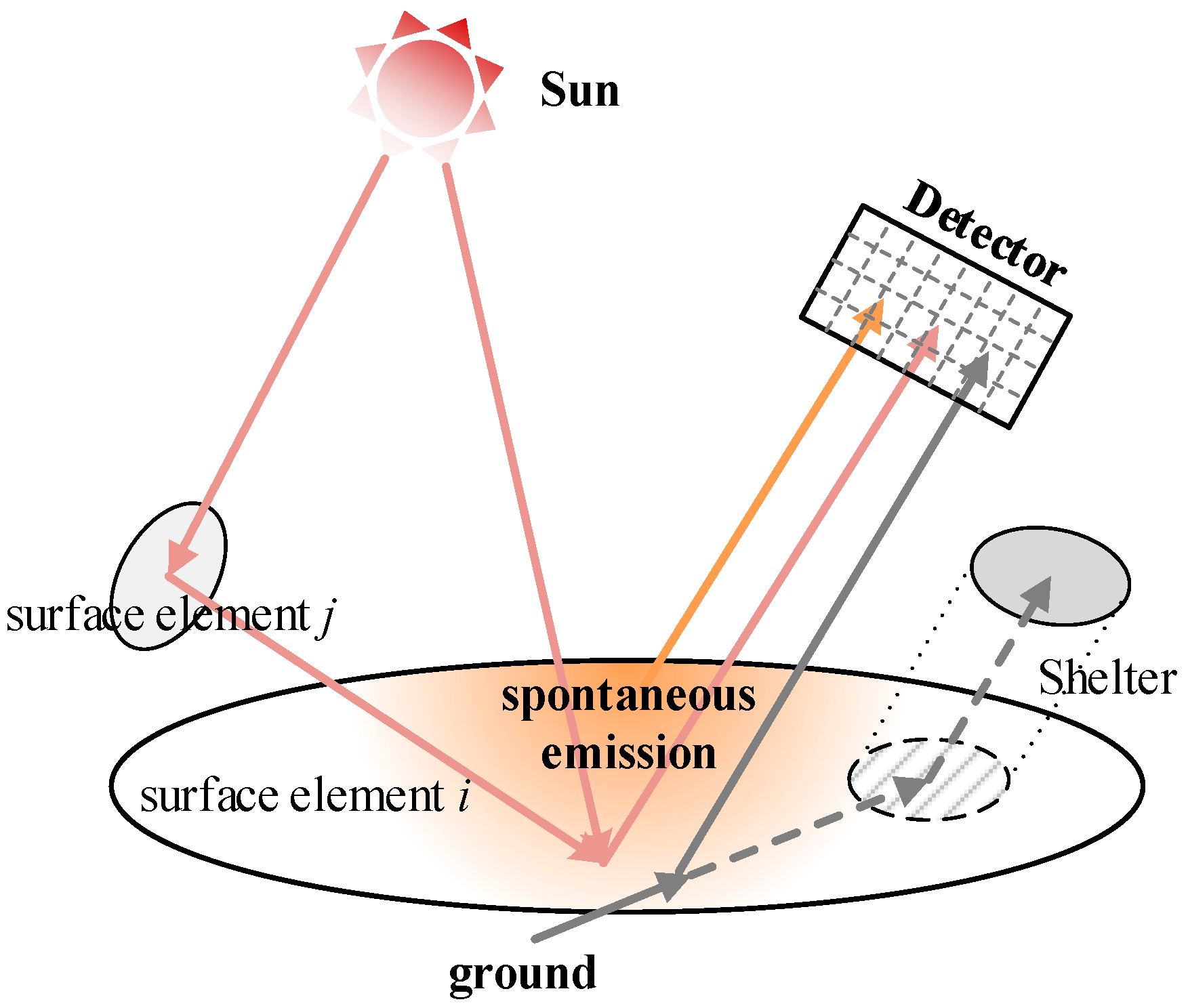
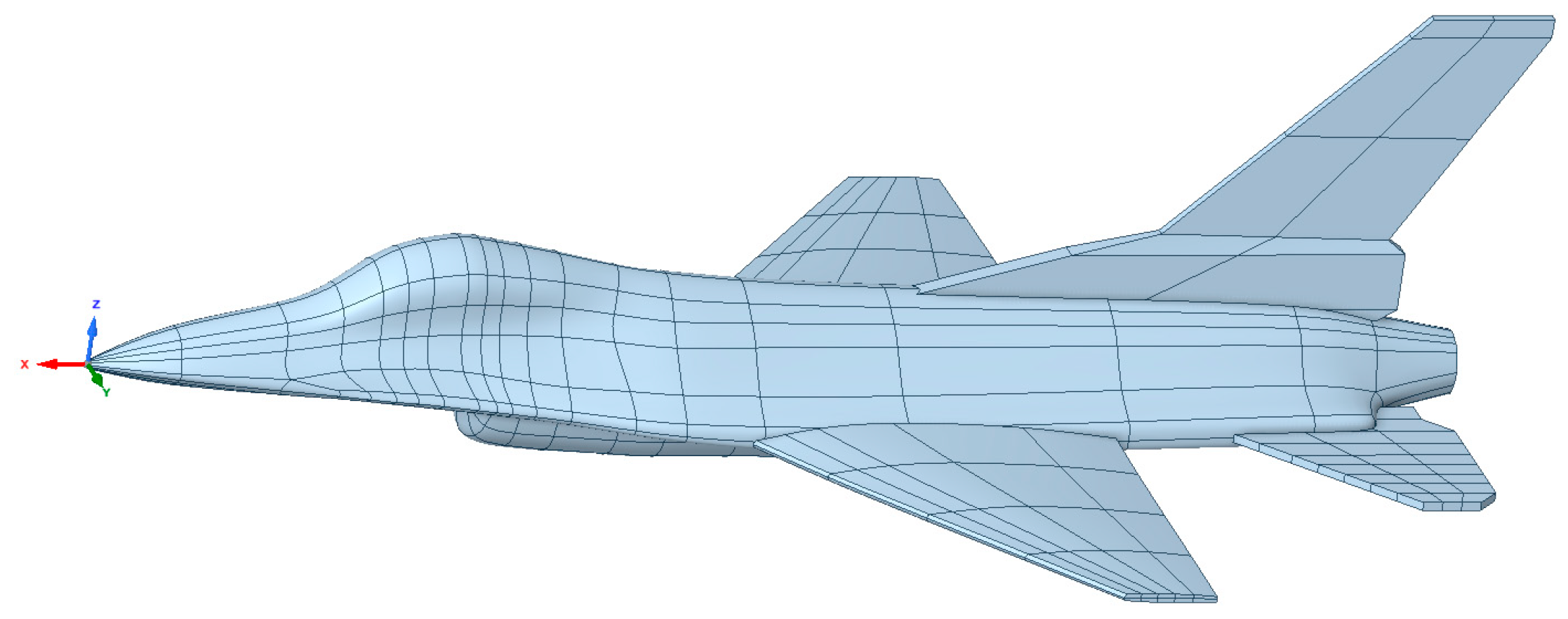

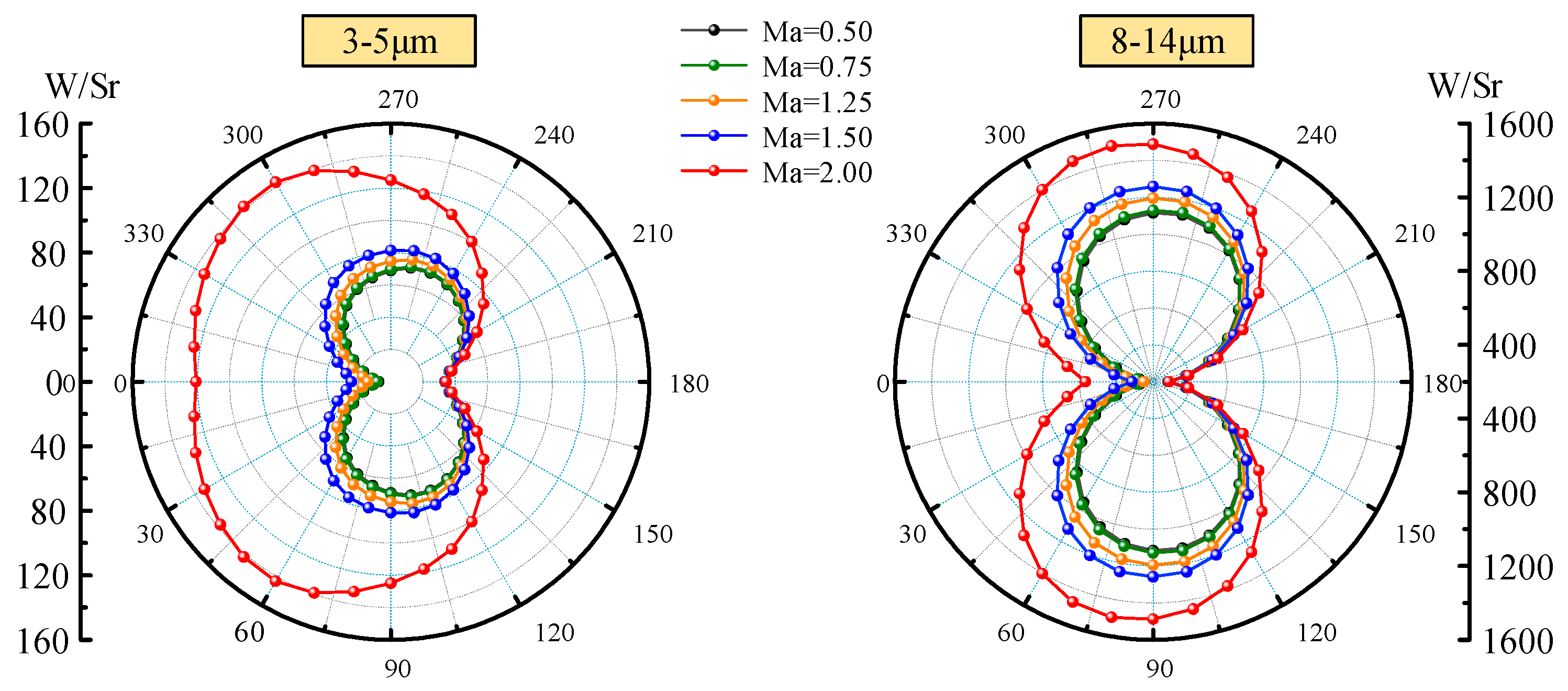
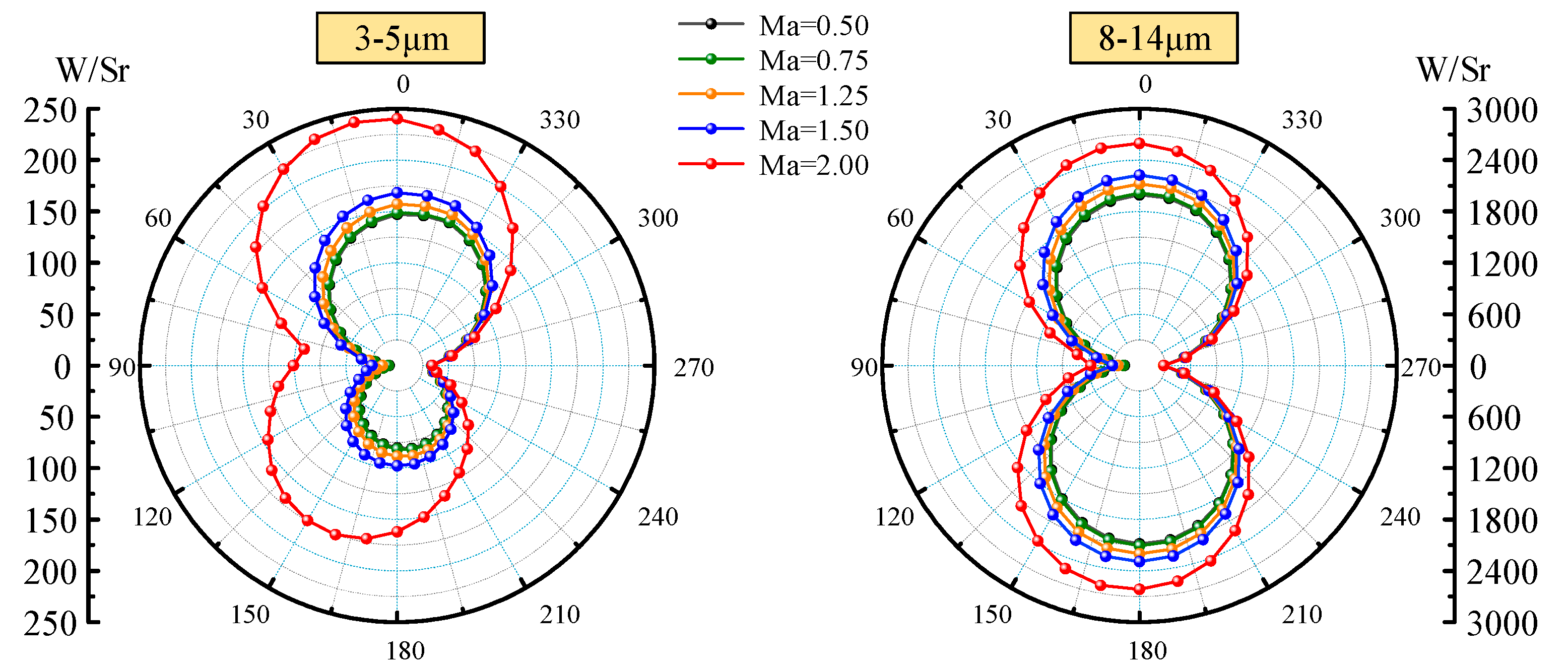
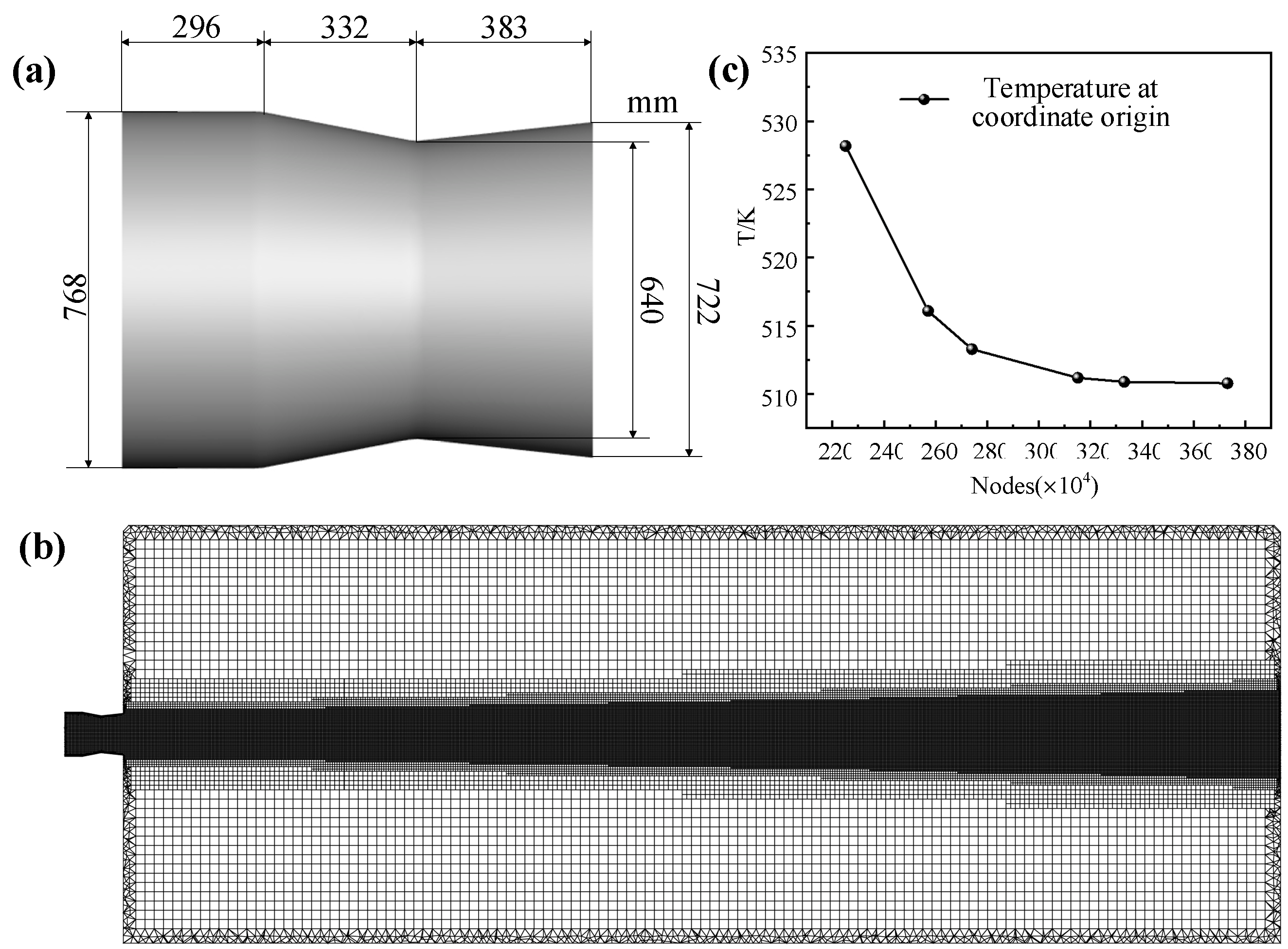
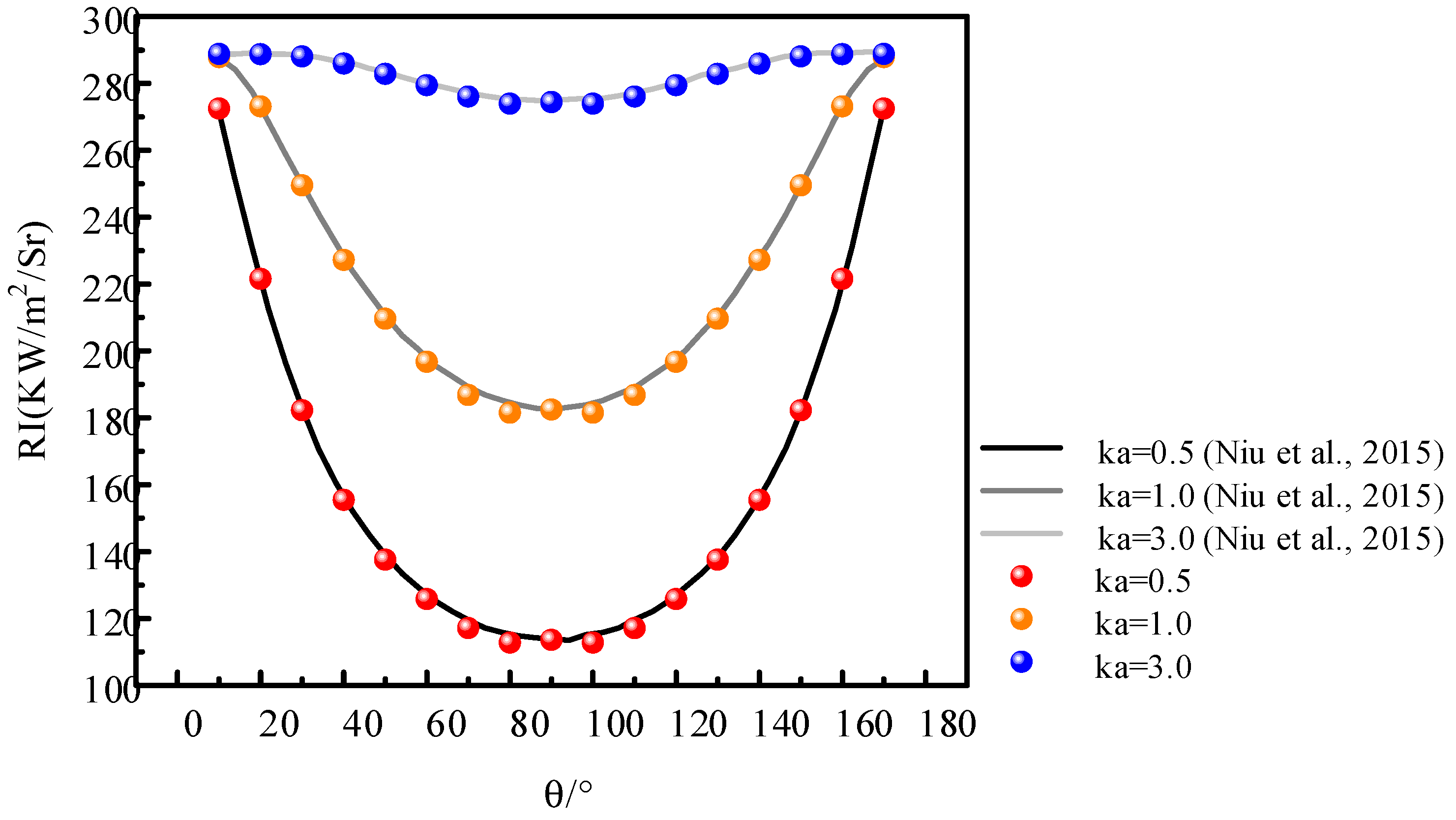
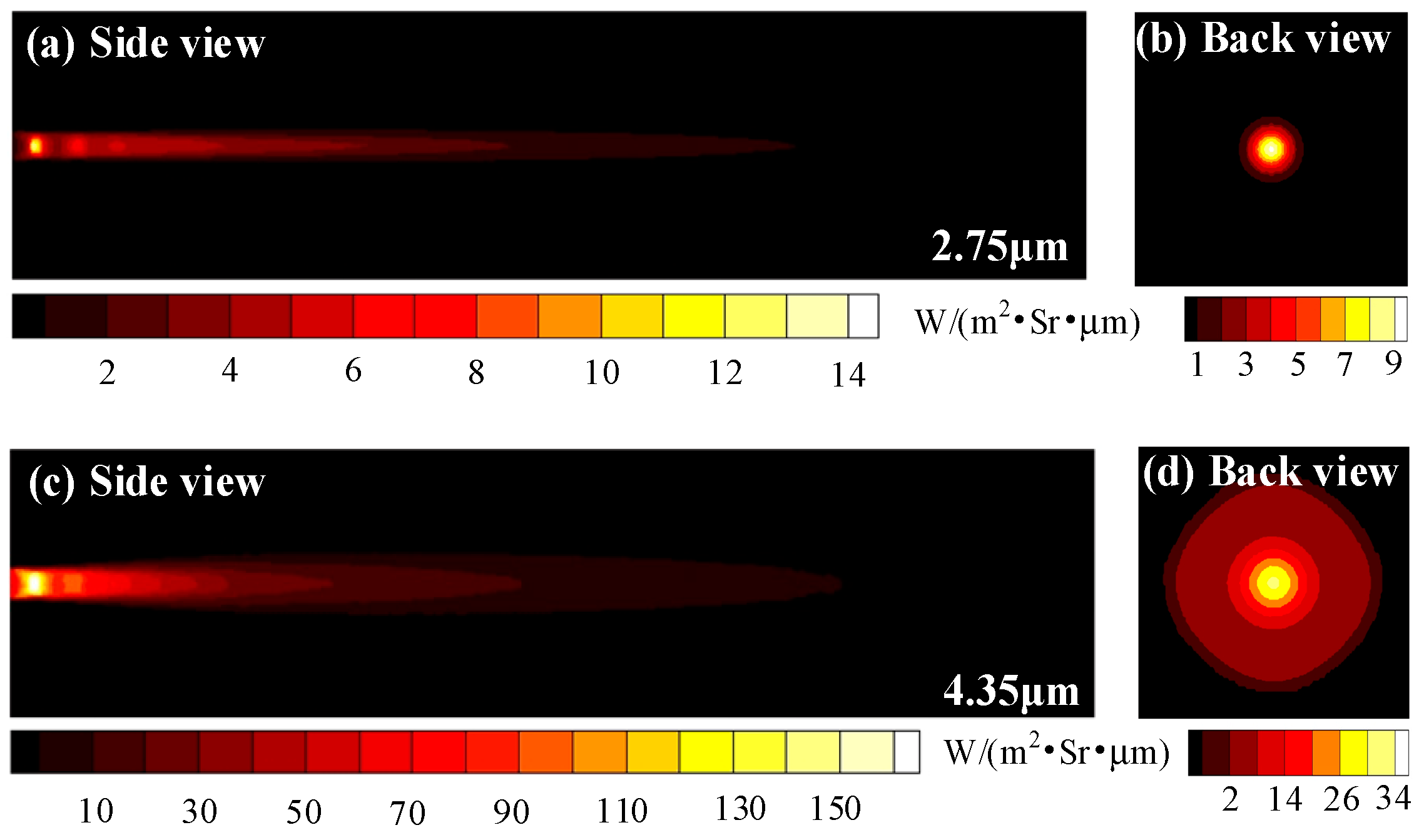
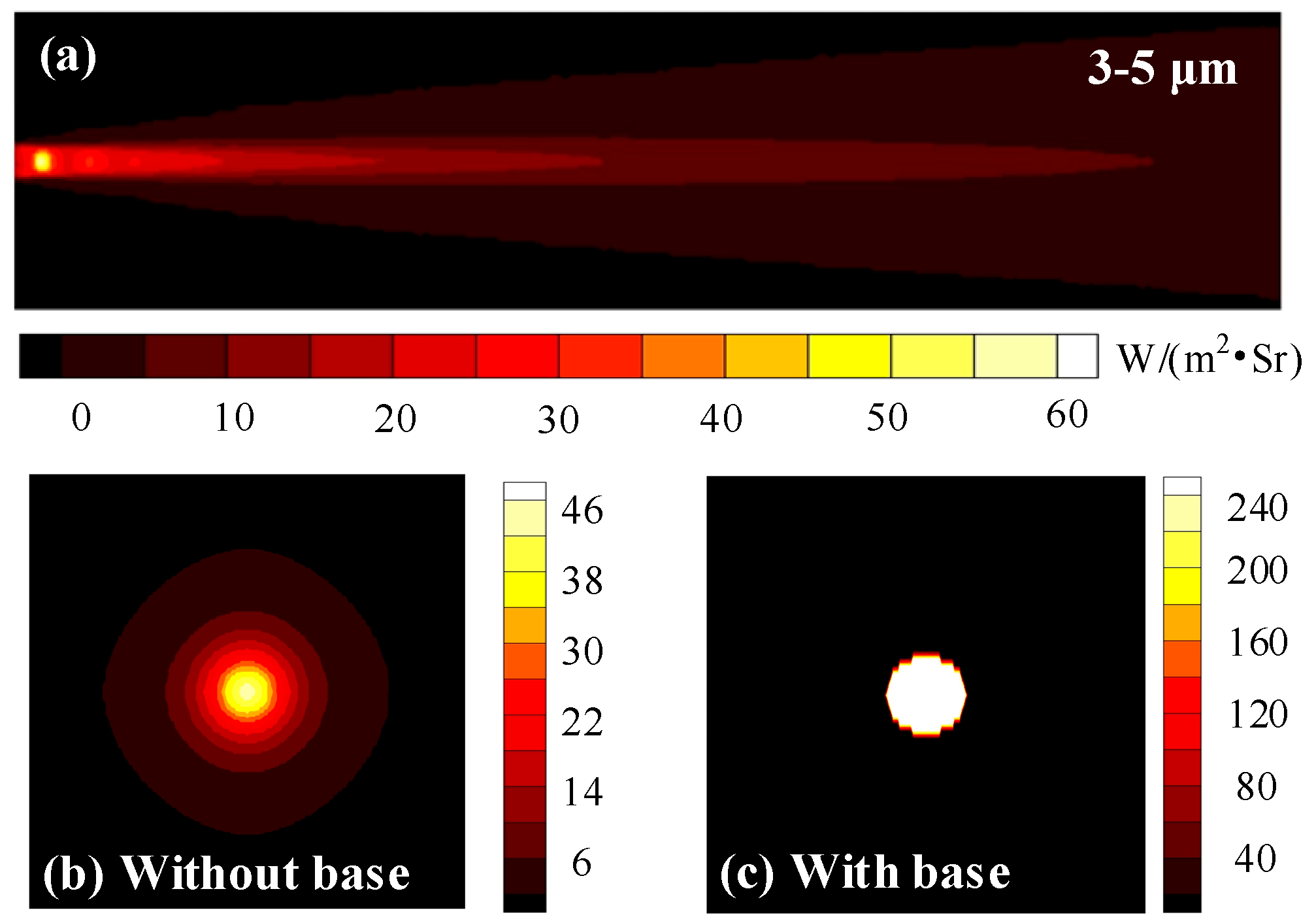
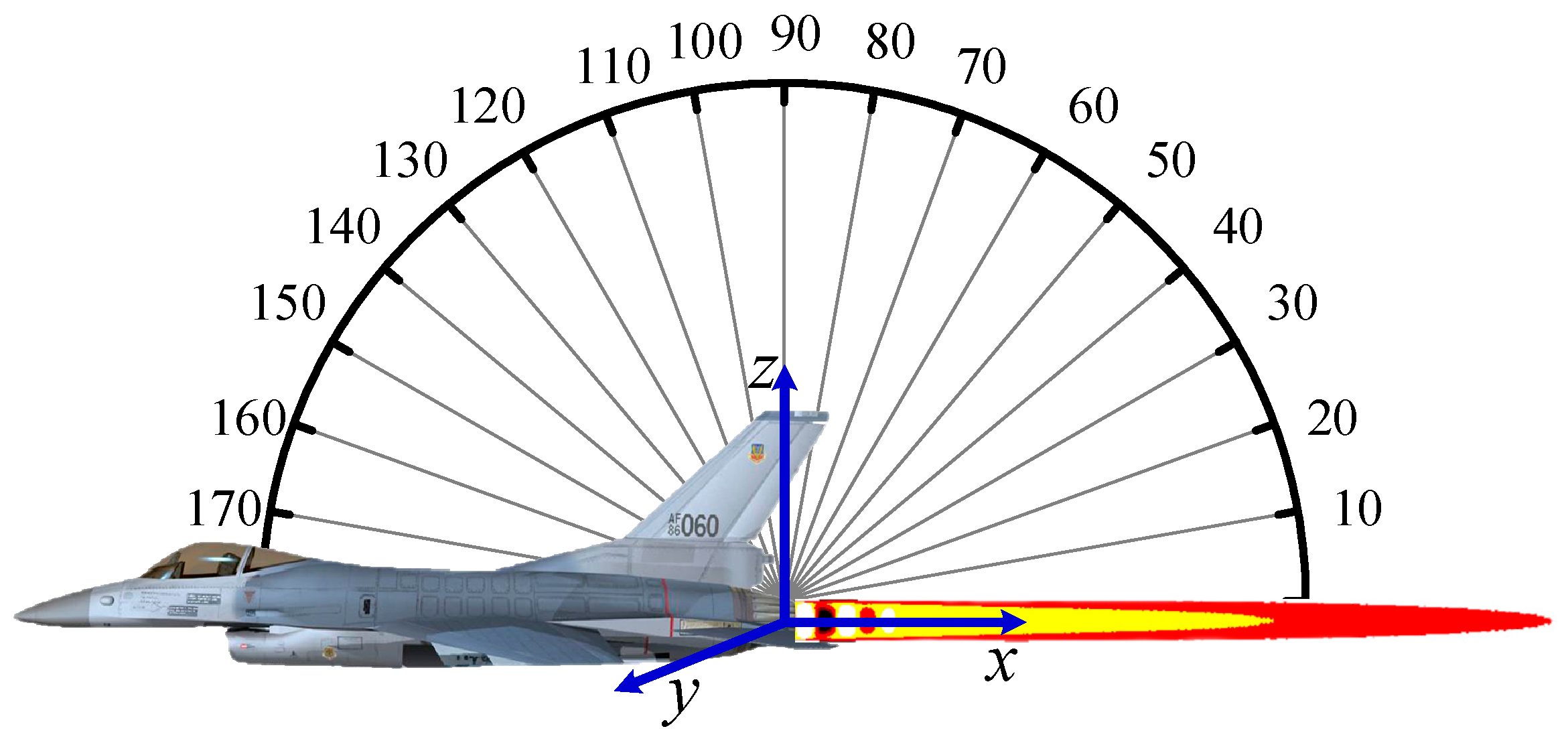
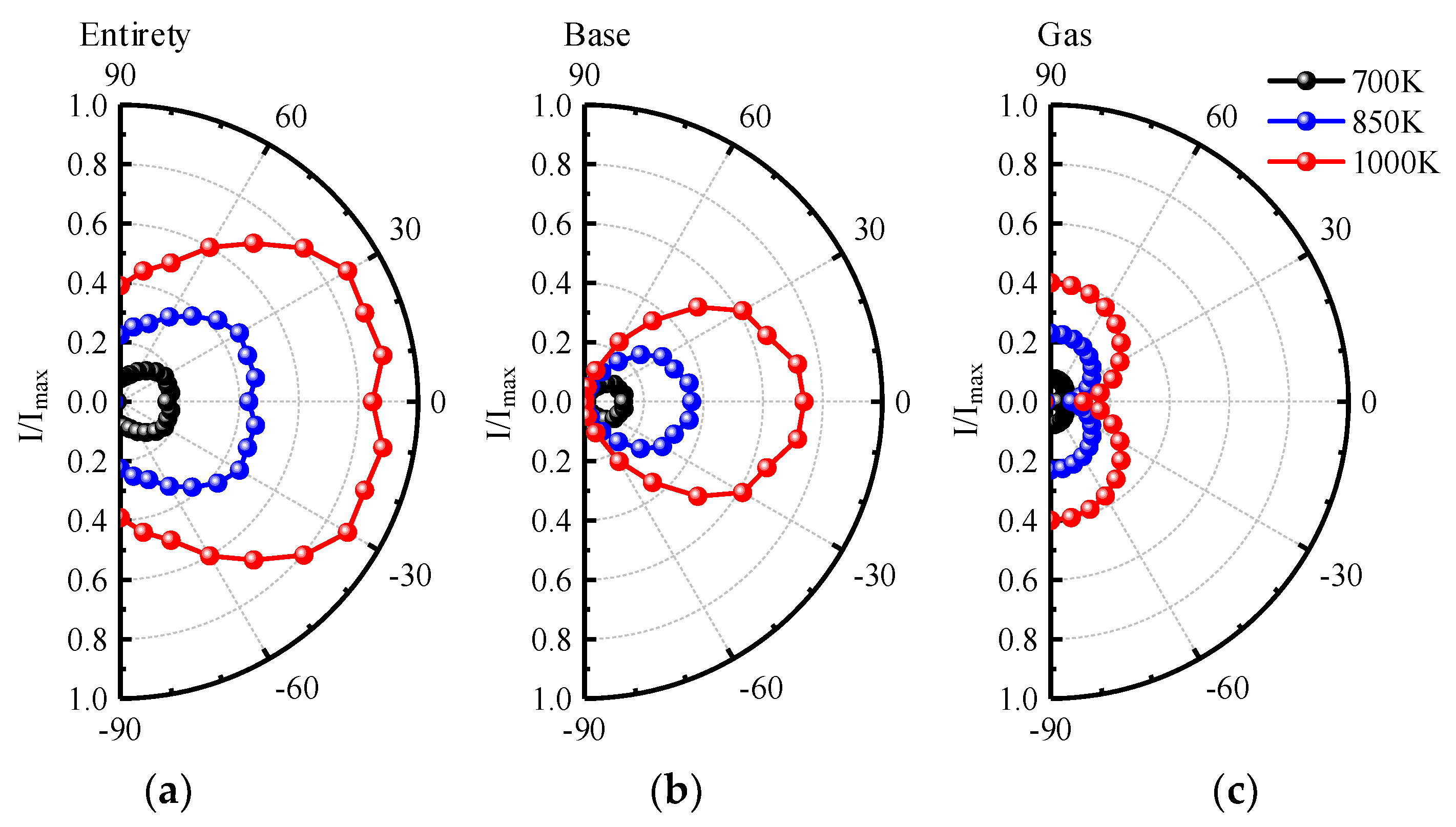
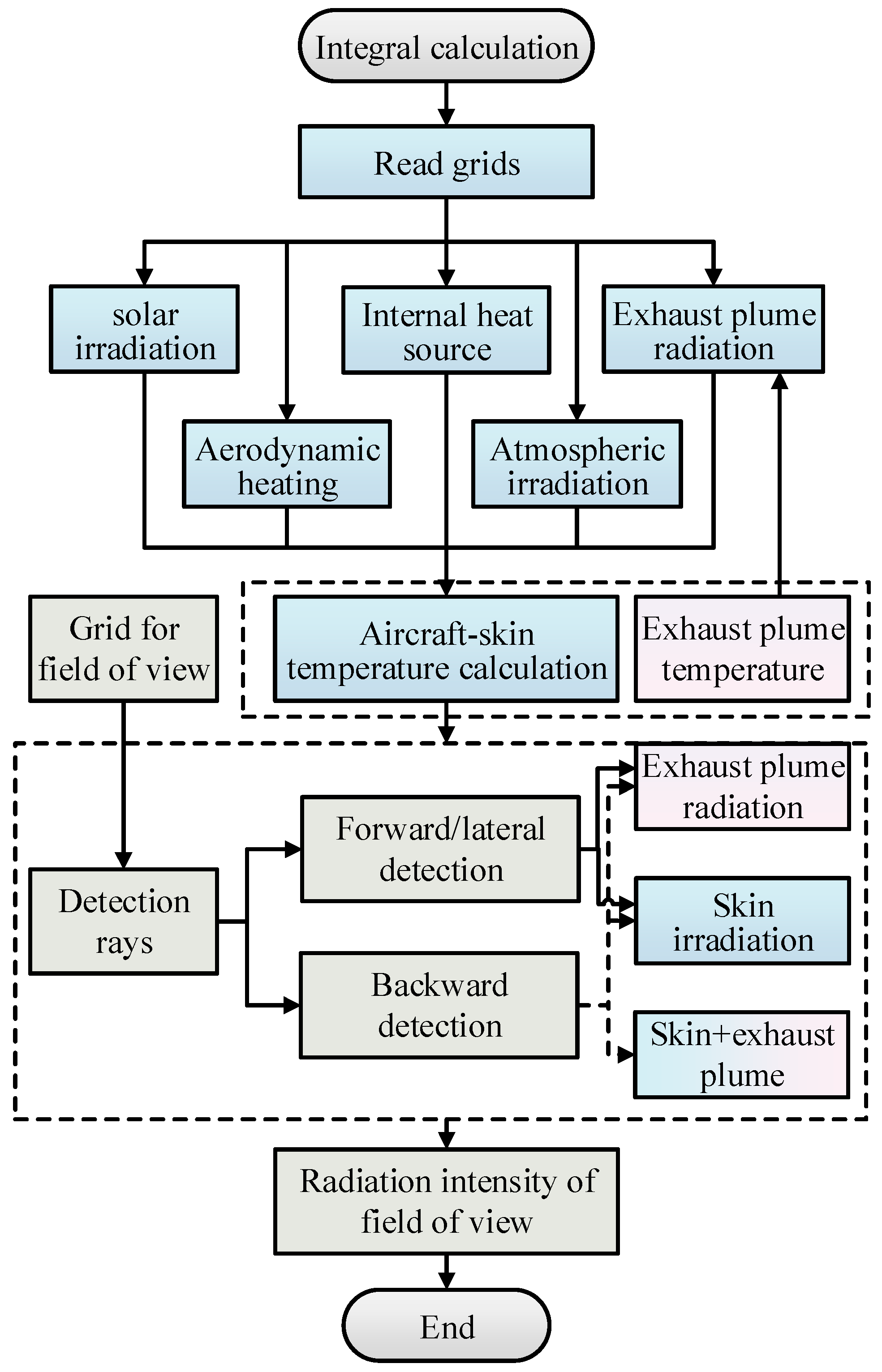
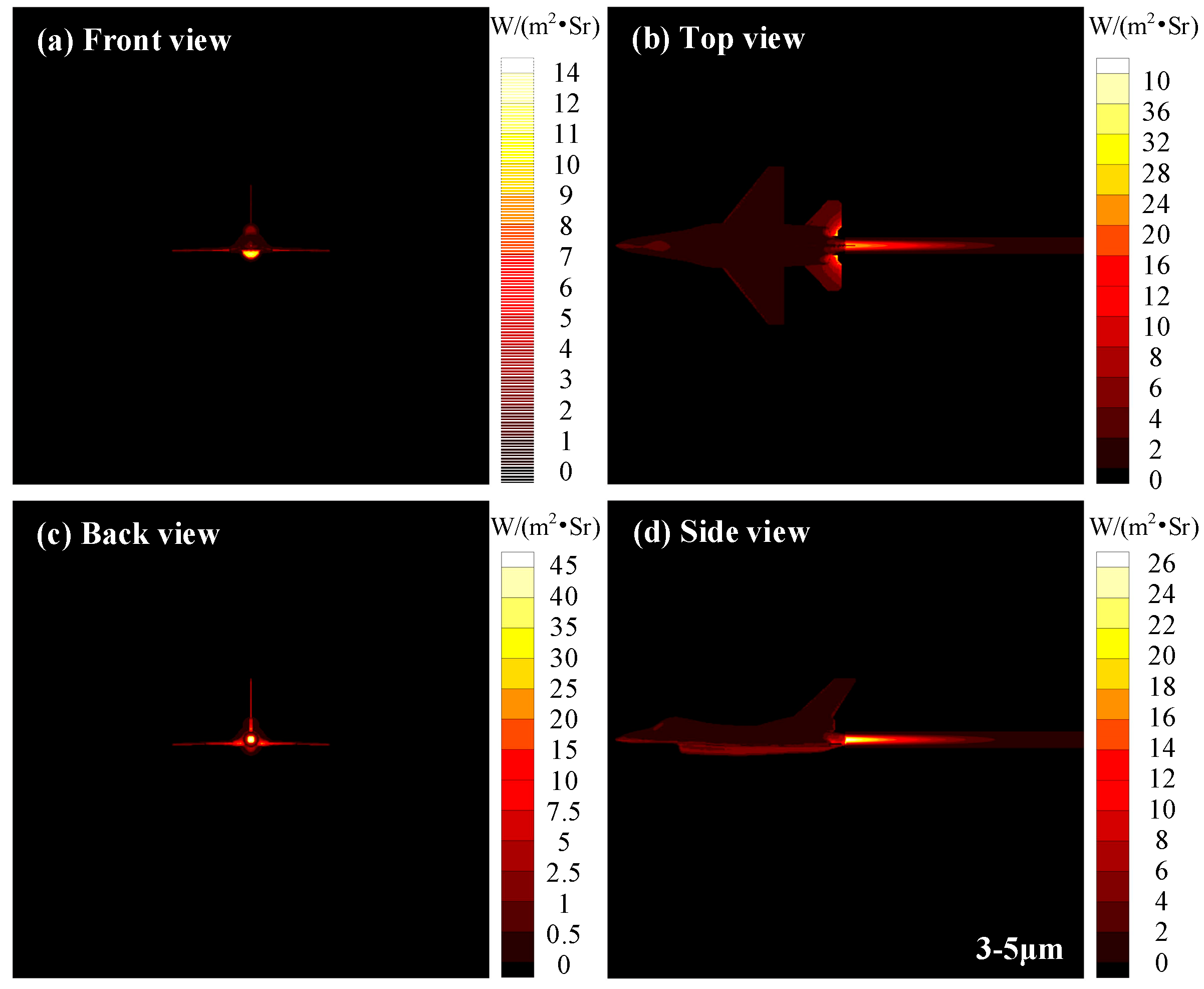

Publisher’s Note: MDPI stays neutral with regard to jurisdictional claims in published maps and institutional affiliations. |
© 2022 by the authors. Licensee MDPI, Basel, Switzerland. This article is an open access article distributed under the terms and conditions of the Creative Commons Attribution (CC BY) license (https://creativecommons.org/licenses/by/4.0/).
Share and Cite
Zhang, J.; Qi, H.; Jiang, D.; Gao, B.; He, M.; Ren, Y.; Li, K. Integrated Infrared Radiation Characteristics of Aircraft Skin and the Exhaust Plume. Materials 2022, 15, 7726. https://doi.org/10.3390/ma15217726
Zhang J, Qi H, Jiang D, Gao B, He M, Ren Y, Li K. Integrated Infrared Radiation Characteristics of Aircraft Skin and the Exhaust Plume. Materials. 2022; 15(21):7726. https://doi.org/10.3390/ma15217726
Chicago/Turabian StyleZhang, Juqi, Hong Qi, Donghang Jiang, Baohai Gao, Mingjian He, Yatao Ren, and Kefu Li. 2022. "Integrated Infrared Radiation Characteristics of Aircraft Skin and the Exhaust Plume" Materials 15, no. 21: 7726. https://doi.org/10.3390/ma15217726
APA StyleZhang, J., Qi, H., Jiang, D., Gao, B., He, M., Ren, Y., & Li, K. (2022). Integrated Infrared Radiation Characteristics of Aircraft Skin and the Exhaust Plume. Materials, 15(21), 7726. https://doi.org/10.3390/ma15217726








